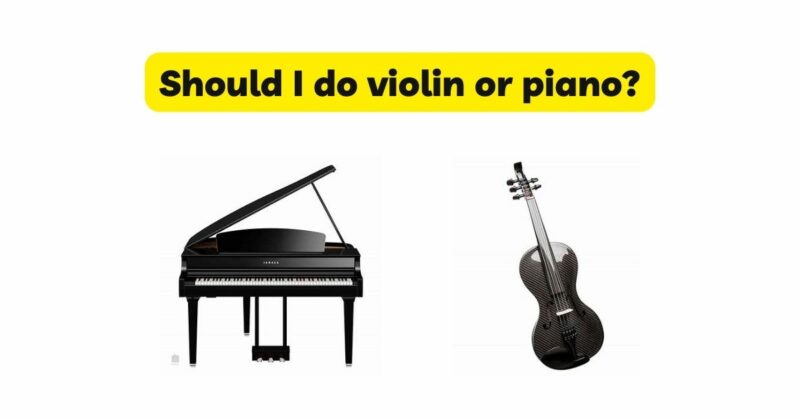When it comes to choosing between the violin and piano, aspiring musicians often find themselves facing a challenging decision. Both instruments offer unique qualities and musical opportunities, making the choice a personal and subjective one. In this article, we will explore the considerations involved in deciding between the violin and piano, including factors such as musical preferences, technical demands, expressive capabilities, learning approaches, and personal goals. By examining these elements, we aim to provide guidance to individuals seeking to make an informed decision that aligns with their musical aspirations and interests.
- Musical Preferences: Understanding your musical preferences is crucial when deciding between the violin and piano. Consider the types of music that resonate with you the most and the sounds that evoke the strongest emotional response. The violin is known for its expressive capabilities, often associated with classical and romantic music, as well as folk and world music genres. Its ability to imitate the human voice and convey a wide range of emotions appeals to those drawn to its rich and captivating sound. On the other hand, the piano’s versatility allows for exploring various musical styles, from classical to jazz, pop, and contemporary genres. If you find yourself deeply moved by the emotive qualities of the violin or enticed by the harmonic possibilities of the piano, it can serve as a strong indicator of your musical preference.
- Technical Demands: Understanding the technical demands of each instrument is essential when making a decision. The violin requires precise finger placement, bow control, and a keen sense of intonation. Mastering techniques such as shifting, vibrato, and bow articulation demands meticulous practice and a solid foundation in violin technique. Additionally, the absence of visual cues such as keys or frets demands a higher level of sensory and kinesthetic awareness. The piano, in contrast, requires finger independence, hand coordination, and the ability to navigate complex musical arrangements. Developing finger dexterity, understanding music theory, and mastering techniques such as scales, arpeggios, and chord progressions are integral to piano proficiency. Consider the technical challenges of each instrument and assess which aligns more closely with your strengths and interests.
- Expressive Capabilities: The expressive capabilities of an instrument play a significant role in personal musical fulfillment. The violin’s unique ability to imitate the human voice and evoke a wide range of emotions through its expressive qualities appeals to those who seek to convey their innermost feelings through their playing. Techniques such as vibrato, bow articulation, and dynamics enable violinists to deliver nuanced musical phrasing and captivating performances. The piano, with its broad dynamic range and versatility, offers the opportunity to explore a diverse spectrum of tonal colors and textures. Pianists can employ techniques such as touch, pedal control, and hand positioning to convey their artistic interpretations. Reflect on which instrument allows you to express yourself most authentically and aligns with your desire to communicate emotions through music.
- Learning Approaches and Progression: The learning approaches and progression associated with each instrument should be considered. The violin has a steep learning curve due to its unique techniques, intricate finger placement, and bowing intricacies. Developing a sensitive ear for intonation, bow control, and finger agility can be challenging for beginners. Moreover, the absence of visual cues demands a higher level of sensory and kinesthetic awareness. The piano offers a more gradual learning curve, particularly for beginners, due to the visual layout of the keyboard and the ability to read music notation more easily. However, mastering advanced piano techniques, sight-reading skills, and coordination between both hands requires dedicated practice, perseverance, and a deep understanding of musical concepts. Reflect on your preferred learning style and assess which instrument’s learning approach resonates more with your ability to grasp new concepts and progress at a pace that is fulfilling for you.
- Personal Goals and Aspirations: Your personal goals and aspirations should guide your decision-making process. Consider what you hope to achieve through learning an instrument. Are you looking to pursue a professional career as a musician, perform in ensembles, or teach others? Or are you seeking to develop a fulfilling hobby, enjoy playing for personal satisfaction, or engage in collaborative music-making with friends and family? Clarifying your goals will help align your decision with the path that best supports your aspirations.
- Long-Term Commitment and Passion: Ultimately, the instrument you choose should be driven by your long-term commitment and passion. Learning either the violin or piano requires dedicated practice, consistent effort, and a lifelong journey of growth and exploration. Consider which instrument resonates more deeply with you and ignites a genuine passion within you. Reflect on the instrument that excites you the most, evokes curiosity, and compels you to invest the time and energy required to develop your skills.
Conclusion: Choosing between the violin and piano is a deeply personal decision that should be guided by your musical preferences, technical demands, expressive capabilities, learning approaches, personal goals, and passion. Take the time to reflect on these factors, seeking guidance from experienced musicians or teachers who can provide insights and advice. Remember that there is no right or wrong choice; both instruments offer rich and rewarding musical experiences. Whichever instrument you choose, embrace the journey with dedication, perseverance, and an open mind, as the joy and fulfillment of playing an instrument lie in the love and passion you bring to your musical endeavors.


